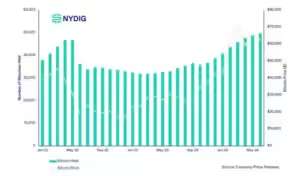Bitcoin Falls Below $68K Amid $64M ETF Outflow and Declining Asian Stocks

QUICK TAKE
- Bitcoin dipped below $68,000 following significant ETF outflows.
- U.S.-listed spot BTC ETFs saw a $64 million outflow on Monday.
- Broader market declines included Asian stocks and major cryptocurrencies.
- Treasury yields fell as investors sought safe-haven assets.
- Market uncertainty heightened by European political developments and upcoming U.S. economic data releases.
Bitcoin experienced a notable decline on Tuesday, falling below the $68,000 mark. This drop comes in the wake of substantial outflows from U.S.-listed spot Bitcoin exchange-traded funds (ETFs) and a broader retreat in Asian equity markets.
On Monday, U.S.-listed spot BTC ETFs registered cumulative outflows exceeding $64 million, marking the first significant loss since late May, according to data from Farside Investors. These outflows contributed to Bitcoin’s price drop, with the leading cryptocurrency by market value falling over 2% to $67,900. Ether, the second-largest cryptocurrency, also followed this downward trend, briefly dipping below $3,550. The CoinDesk 20 Index, which tracks the performance of the top 20 cryptocurrencies, fell by 1% to 2,370 points.
The recent outflows from Bitcoin ETFs are a stark contrast to the strong inflows observed in previous weeks. Market chatter suggests that these inflows were primarily driven by institutional interest in non-directional basis trades rather than outright bullish bets. This shift in trading sentiment likely contributed to the recent decline in Bitcoin’s price.
In traditional financial markets, Chinese stocks led the losses in Asian equity indices, falling over 1% amid ongoing concerns about the property market and reports that the Bank of Japan may reduce its liquidity-boosting bond purchases this week. The broader decline in Asian stocks reflects a general sense of unease among investors, who are increasingly seeking safer investments.
The dollar index, which measures the U.S. dollar’s strength against a basket of major currencies, consolidated its gains over the past two days. Meanwhile, prices for U.S. Treasuries, considered a safe haven asset, ticked higher, resulting in lower yields. The yield on the benchmark 10-year Treasury note fell by three basis points to 4.45%, as reported by TradingView.
Political developments in Europe added to the market’s uncertainty. Recent gains for right-wing parties in European elections and the announcement of a snap poll in France raised concerns about the cohesion of the European Union. These political events have introduced additional volatility into the market, as investors assess the potential implications for the region’s economic stability.
In the U.S., anticipation for Wednesday’s Consumer Price Index (CPI) release and the Federal Reserve’s rate decision has kept investors on edge. The Federal Open Market Committee (FOMC) meeting will provide the latest quarterly projections, including the interest rate dot plot, which outlines policymakers’ expectations for future rate hikes. These projections will be closely scrutinized for indications of the Fed’s monetary policy direction in the coming months.
As Bitcoin and other major cryptocurrencies face downward pressure, the broader market sentiment remains cautious. The interplay between traditional financial markets and the crypto sector is increasingly evident, with macroeconomic factors and institutional trading behaviors significantly influencing digital asset prices.
The recent decline in Bitcoin’s price highlights the cryptocurrency’s volatility and the impact of ETF flows on its market value. While institutional interest in non-directional basis trades has driven recent inflows, the significant outflows observed this week underscore the market’s sensitivity to shifting investor sentiment.
In conclusion, Bitcoin’s dip below $68,000 and the broader market declines reflect a confluence of factors, including significant ETF outflows, declining Asian stocks, and investor uncertainty driven by political and economic developments. As the crypto and traditional financial markets navigate these challenges, investors will continue to closely monitor key indicators, such as the upcoming U.S. CPI release and the Federal Reserve’s rate decision, for further insights into the market’s direction.



